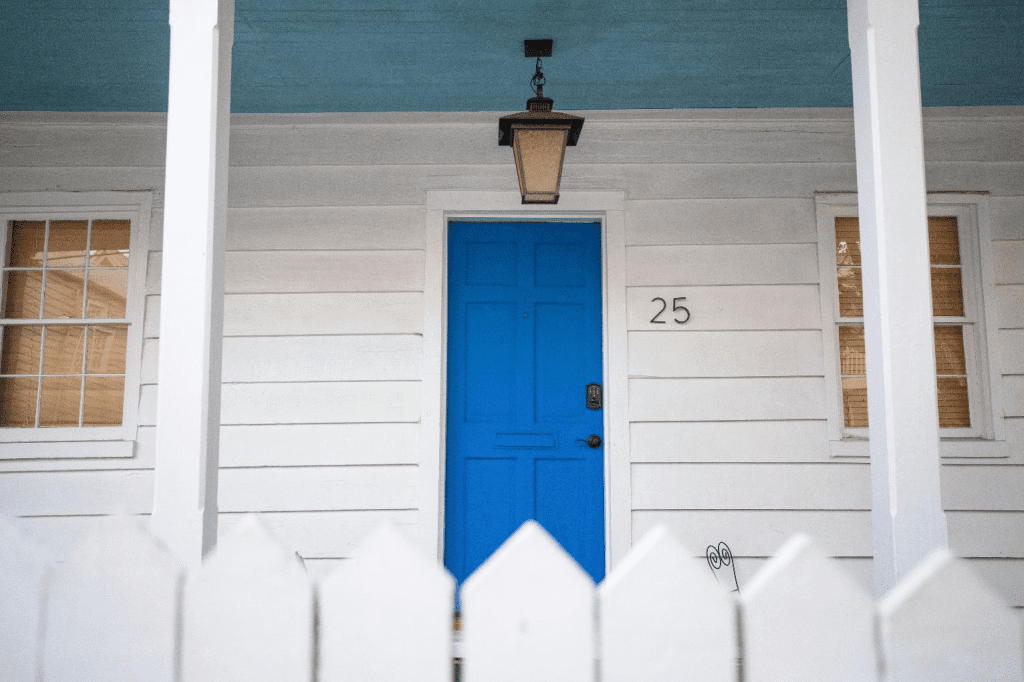If you spend any time relaxing or socializing on a front porch, chances are you’ve seen porch ceilings painted in various colors. Many are white or wooden, but if you’re in the South, you might notice something different—blue porch ceilings. While painting porch ceilings blue may seem like a simple design choice, it actually holds a rich and fascinating history in Southern culture. For over 200 years, Southerners have embraced this practice, and its roots go deeper than just aesthetics.
The Origins of Blue Porch Ceilings: Gullah Geechee Traditions

The history of blue porch ceilings in the South can be traced back to the Gullah Geechee people, an African American community living primarily in the coastal regions of Florida, Georgia, and South Carolina. The Gullah Geechee, descendants of enslaved Africans, developed unique cultural practices and traditions, one of which involved painting porch ceilings blue.
According to Gullah folklore, malevolent spirits—referred to as “haints”—were believed to roam the earth, causing harm or mischief. These spirits were thought to be trapped on plantations due to the violent and oppressive history of slavery in the South. The Gullah Geechee believed that these haints were unable to cross water, which led to the tradition of painting porch ceilings blue to mimic the color of water. This practice was intended to protect homes by tricking the spirits into thinking they couldn’t enter, thus safeguarding the inhabitants.
The shade of blue used is often referred to as “haint blue,” a soft, pale-to-medium blue that was chosen specifically for its resemblance to water. Over time, this tradition spread throughout the South, becoming a staple of Southern home design.
The Spiritual Significance: Keeping “Haints” at Bay
The idea of using blue to protect against spirits is rooted in the Gullah Geechee belief system. Haints, or restless spirits, were feared because of their perceived ability to bring misfortune. By painting the ceiling, windows, and doors blue, residents believed they could create a spiritual barrier, preventing these spirits from entering the home.
This practice highlights the deep cultural ties that Southern communities have with folklore and spiritual beliefs. Even as modern society moves away from superstition, the tradition of blue porch ceilings persists as a nod to the region’s rich cultural heritage.
Aesthetic and Practical Benefits of Blue Porch Ceilings
While the spiritual reasoning is the most well-known explanation for blue porch ceilings, there are other, more practical reasons why homeowners in the South continue this tradition.
- Insect Deterrent: Some believe that painting the porch ceiling blue helps deter insects, particularly wasps, from building nests. The theory is that wasps mistake the blue ceiling for the sky and avoid nesting there. Although the effectiveness of this method is debated, many Southerners still swear by it as a natural way to keep pests at bay.
- Creating an Illusion of Extended Daylight: Another reason some people choose blue for their porch ceiling is to create the illusion of extended daylight. A pale blue ceiling can reflect sunlight, making the porch feel brighter and more open. This subtle change can help create a peaceful, relaxing space, even as the sun begins to set.
- Adding a Pop of Color: For many homeowners, the decision to paint a porch ceiling blue is purely aesthetic. It’s a charming, nostalgic color that adds warmth and character to a home. In an era where neutral tones dominate interior design, a blue ceiling offers a refreshing splash of color that still feels classic.
Blue Ceilings and Southern Nostalgia

Beyond the practical and spiritual reasons, the blue porch ceiling evokes a strong sense of nostalgia in the South. For many, the sight of a blue ceiling brings back memories of lazy afternoons spent on grandparents’ porches, sweet tea in hand, with the gentle hum of cicadas in the background. It’s a symbol of Southern hospitality, a welcoming feature that invites neighbors and friends to sit and stay a while.
The tradition of blue porch ceilings has become deeply embedded in the identity of Southern homes. In cities like Charleston, Savannah, and New Orleans, historic homes with blue ceilings dot the landscape, each one carrying with it a piece of the region’s cultural history.
Modern Interpretations of the Blue Porch Ceiling
While the origins of blue porch ceilings are steeped in folklore and tradition, modern homeowners have embraced this trend for new reasons. Some appreciate the historical connection, while others simply love the look of a blue ceiling. Homeowners across the country—not just in the South—are beginning to adopt this practice, giving it a more widespread appeal.

Today, shades of haint blue can be found on porches in various regions, reflecting both its aesthetic charm and its deep-rooted history. From contemporary homes to vintage cottages, this tradition continues to thrive, bridging the gap between past and present.
Conclusion: The Enduring Legacy of Blue Porch Ceilings
Next time you find yourself in the South, take a look up when you’re sitting on a front porch. If you see a blue ceiling, you now know the story behind it. What began as a protective measure against spirits has evolved into a beloved design choice with a rich cultural background. Whether for spiritual reasons, to keep insects away, or simply to create a serene space, the blue porch ceiling remains a timeless feature of Southern architecture.
This tradition serves as a reminder of the deep connections between culture, design, and folklore. It’s a small detail that speaks volumes about the history of the region and the ways in which the past continues to influence the present.


